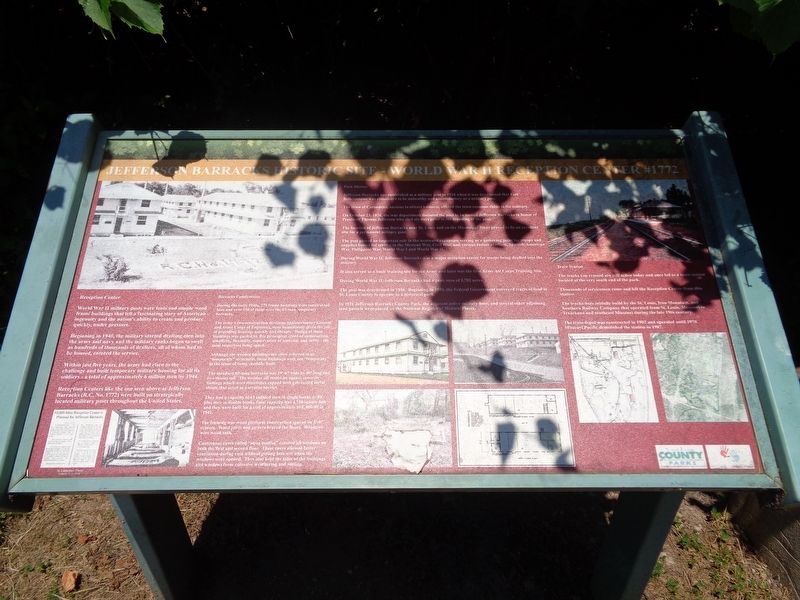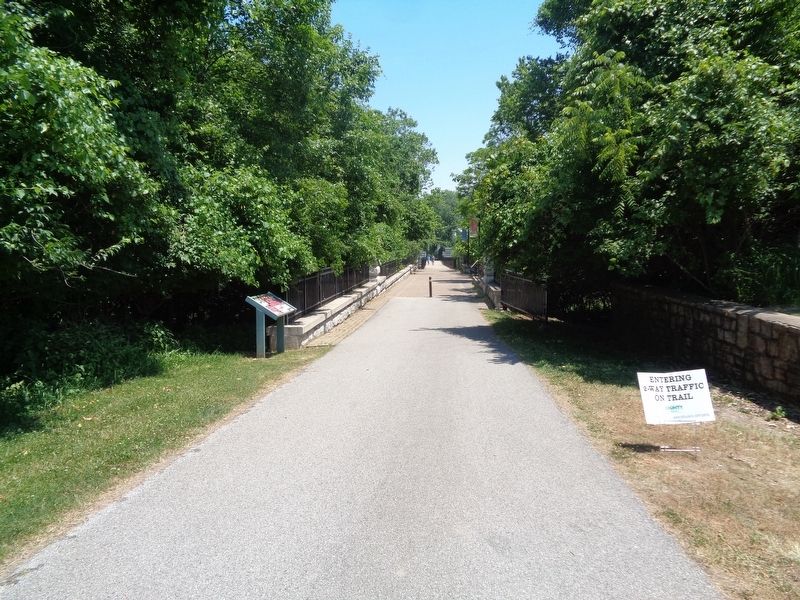Lemay in St. Louis County, Missouri — The American Midwest (Upper Plains)
Jefferson Barracks Historic Site - World War II Reception Center #1772
Inscription.
Reception Center
World War II military posts were tents and simple wood frame buildings that tell a fascinating story of American ingenuity and the nation's ability to create and produce quickly, under pressure.
Beginning in 1940, the military started drafting men into the army and navy and the military ranks began to swell as hundreds of thousands of draftees, all of whom had to be housed, entered the service.
Within just five years, the army had risen to the challenge and built temporary military housing for all its soldiers - a total of approximately 6 million men by 1944.
Reception Centers like the one seen above at Jefferson Barracks (R.C. No. 1772) were built on strategically located military posts throughout the United States.
Barracks Construction
During the early 1940s, 275 frame buildings were constructed here and over 150 of them were the 63-man temporary barracks.
The army's two construction divisions, Quartermaster General and Army Corps of Engineers, were immediately given the job of providing housing, quickly and cheaply. Design of these buildings was guided by five principles: speed of construction simplicity, flexibility, conservation of material, and safety - the most important being speed.
Although the wooden buildings are often referred to as "temporary" structures, these buildings were not "temporary" in the sense of being shoddily built.
The standard 63-man barracks was 29'-6" wide by 80' long and two stories tall. The wooden sill rested on square concrete footings which were sometimes capped with galvanized metal sheets that acted as a termite barrier.
They had a capacity of 63 enlisted men in single bunks or 80 plus men in double bunks. Total capacity was 4,730 square feet and they were built for a cost of approximately $10,000.00 in 1941.
The framing was wood platform construction spaced on 3'0" centers. Wood joists and girders braced the floors. Windows were wood sash.
Continuous eaves called "aqua medias" covered all windows on both the first and second floor. These eaves allowed better ventilation during rain without getting cots wet when the windows were opened. They also kept the sides of the buildings and windows from excessive weathering and rotting.
Park History
Jefferson Barracks was established as a military post in 1826 when it was determined that Fort Bellefontaine was considered to be unhealthy and unsatisfactory as a military post.
The town of Carondelet, anxious to attract business, offered the town common fields to the military.
On October 23, 1826, the war department declared the
post to be named Jefferson Barracks in honor of President Thomas Jefferson who died six days prior to the founding of the post.
The location of Jefferson Barracks near St. Louis and on the Mississippi River proved to be an excellent site for a permanent military post.
The post played an important role in the westward expansion serving as a gathering point for troops and supplies bound for service in the Mexican War, Civil War, and various Indian conflicts, Spanish-American War, Philippine War, World War I and World War II.
During World War II, Jefferson Barracks was a major reception center for troops being drafted into the military.
It also served as a basic training site for the Army and later was the first Army Air Corps Training Site.
During World War II, Jefferson Barracks had a peak area of 1,702 acres.
The post was deactivated in 1946. Beginning in 1950, the Federal Government conveyed tracts of land to St. Louis County to operate as a historical park.
In 1971 Jefferson Barracks County Park, the adjacent active military base, and several other adjoining land parcels were placed on the National Register of Historic Places.
Train Station
The tracks you crossed are still active today and once led to a train station located at the very south end of the park.
Thousands of servicemen came and left the Reception Center from this station.
The tracks were initially build by the St. Louis, Iron Mountain, and Southern Railway Company that operated from St. Louis, Missouri to Texarkana and southeast Missouri during the late 19th century.
The train depot was constructed in 1902 and operated until 1970. Missouri Pacific demolished the station in 1987.
Erected 2009 by Friends of Jefferson Barracks and Saint Louis County Parks.
Topics. This historical marker is listed in these topic lists: Parks & Recreational Areas • Railroads & Streetcars • War, World II. A significant historical date for this entry is October 23, 1826.
Location. 38° 31.21′ N, 90° 16.315′ W. Marker is in Lemay, Missouri, in St. Louis County. Marker is on Mississippi River Greenway, on the left when traveling east. The marker is located off a bike path (the Mississippi River Greenway) that goes from Jefferson Barracks Park to River City Casino. Touch for map. Marker is at or near this postal address: 9880 Mississippi River Greenway, Saint Louis MO 63125, United States of America. Touch for directions.
Other nearby markers. At least 8 other markers are within walking distance of this marker. Jefferson Barracks - At the Confluence of American History (within shouting distance of this marker); Jefferson Barracks Historic Site - Old Ordnance Room (about 400 feet away, measured in a direct line); A Longstanding, Strategically Central Military Post (about 400 feet away); Jefferson Barracks Historic Site - Tent City (about 400 feet away); Operation Desert Shield & Desert Storm (approx. 0.2 miles away); Missouri Military Memorial (approx. 0.2 miles away); Jefferson Barracks - A River Flowing Through Time (approx. 0.2 miles away); The Lewis and Clark Expedition Across Missouri (approx. 0.2 miles away). Touch for a list and map of all markers in Lemay.
More about this marker. The marker was originally placed by the Old Ordnance Room in 2009, but it was moved to its current location after the bike path was completed. It was the first of many markers that were placed all over Jefferson Barracks Park.
Credits. This page was last revised on June 20, 2020. It was originally submitted on June 19, 2020, by Jason Voigt of Glen Carbon, Illinois. This page has been viewed 678 times since then and 105 times this year. Photos: 1, 2. submitted on June 19, 2020, by Jason Voigt of Glen Carbon, Illinois. • J. Makali Bruton was the editor who published this page.

